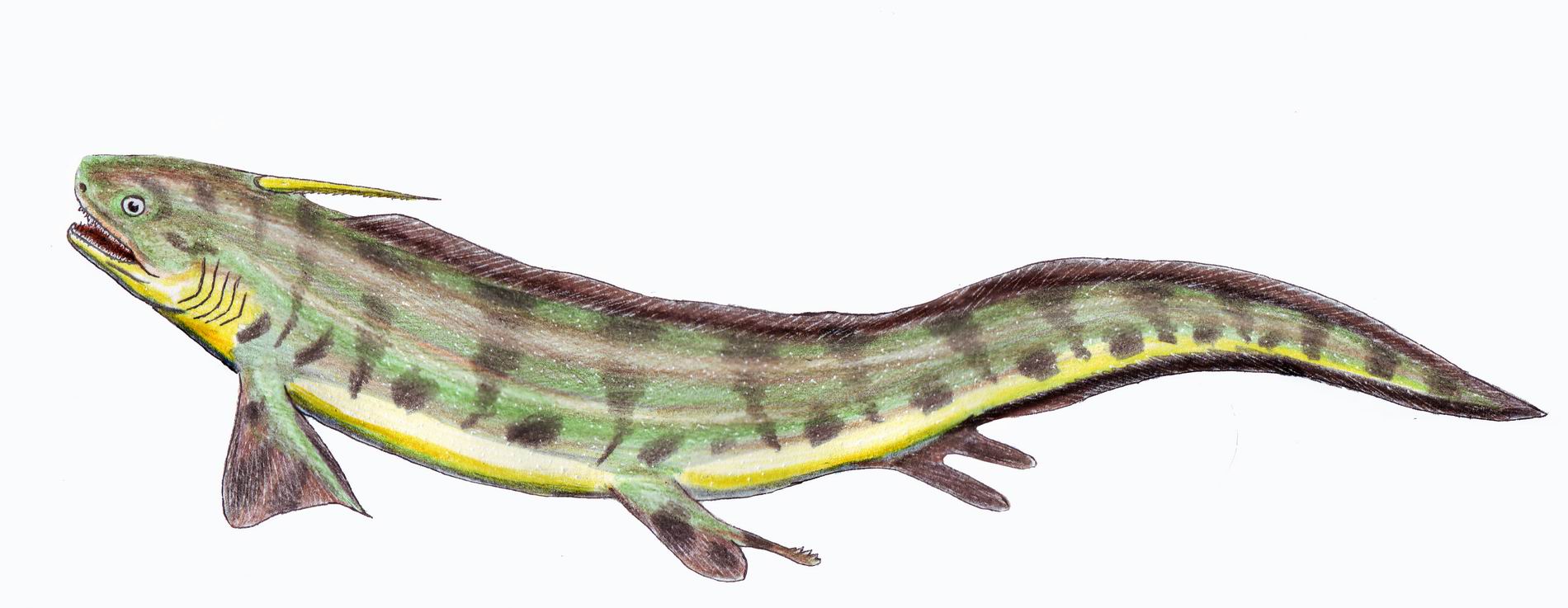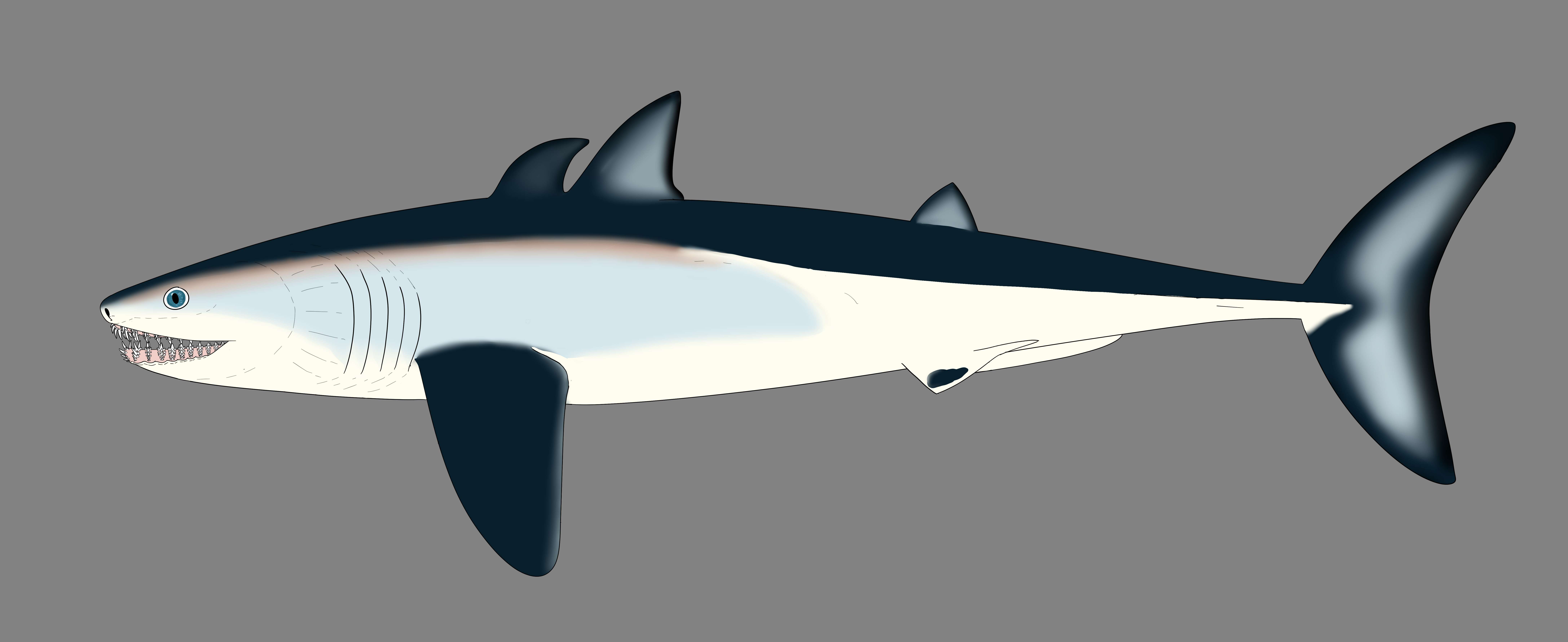|
Squatinactidae
''Squatinactis'' is a genus of extinct elasmobranch Chondrichthyes known from the Carboniferous aged Bear gulch limestone in Montana. This fish was discovered in 1974 by Richard Lund. The type specimen, named CMNH 46133, consists of a brain case, poorly preserved jaws and gills, a pectoral fin, and a partial vertebral axis. This creatures most startling feature were its broad pectoral fins which resembled those of Stingrays and Angel sharks ( ''Squatina''). The holotype specimen has about 15 teeth in its jaw. This creature is named after the angel shark. Teeth found in Derbyshire, England have been tentatively identified as those belonging to ''S. caudispinatus.'' Description ''Squatinactis'' had a flattened body with a set of large pectoral fins. This fish was vaguely similar to today's stingrays and angel sharks. The flins were oddly pointed forward, with a length of around two feet long. It also had a long, whip-like tail with a spine (a feature analogous to some rays) that ... [...More Info...] [...Related Items...] OR: [Wikipedia] [Google] [Baidu] |
Serpukhovian
The Serpukhovian is in the ICS geologic timescale the uppermost stage or youngest age of the Mississippian, the lower subsystem of the Carboniferous. The Serpukhovian age lasted from Ma to Ma. It is preceded by the Visean and is followed by the Bashkirian. The Serpukhovian correlates with the lower part of the Namurian Stage of European stratigraphy and the middle and upper parts of the Chesterian Stage of North American stratigraphy. Name and definition The Serpukhovian Stage was proposed in 1890 by Russian stratigrapher Sergei Nikitin and was introduced in the official stratigraphy of European Russia in 1974. It was named after the city of Serpukhov, near Moscow. The ICS later used the upper Russian subdivisions of the Carboniferous in its international geologic time scale. The base of the Serpukhovian is informally defined by the first appearance of the conodont '' Lochriea ziegleri'', though the utility and systematic stability of this species is not yet certain. No ... [...More Info...] [...Related Items...] OR: [Wikipedia] [Google] [Baidu] |
Derbyshire
Derbyshire ( ) is a ceremonial county in the East Midlands, England. It includes much of the Peak District National Park, the southern end of the Pennine range of hills and part of the National Forest. It borders Greater Manchester to the north-west, West Yorkshire to the north, South Yorkshire to the north-east, Nottinghamshire to the east, Leicestershire to the south-east, Staffordshire to the west and south-west and Cheshire to the west. Kinder Scout, at , is the highest point and Trent Meadows, where the River Trent leaves Derbyshire, the lowest at . The north–south River Derwent is the longest river at . In 2003, the Ordnance Survey named Church Flatts Farm at Coton in the Elms, near Swadlincote, as Britain's furthest point from the sea. Derby is a unitary authority area, but remains part of the ceremonial county. The county was a lot larger than its present coverage, it once extended to the boundaries of the City of Sheffield district in South Yorkshire ... [...More Info...] [...Related Items...] OR: [Wikipedia] [Google] [Baidu] |
Triodus
''Triodus'' is an extinct genus of xenacanthidan shark that lived from the Carboniferous to the Triassic. It was a freshwater shark, and fossils have been found in the Chinle Formation and Black Prince Limestone of Arizona, the Petrified Forest Member of New Mexico and the Tecovas Formation of Texas, United States.''Triodus'' at .org In 2017, a new species ''Triodus richterae'' was described from the Rio do Rasto Formation of |
Thrinacoselache
''Thrinacodus'' is an extinct genus of basal elasmobranch, found worldwide from the Late Devonian-Lower Carboniferous. Most species are only known from their tricuspid teeth. ''T. gracia'', originally placed in the separate genus ''Thrinacoselache'' from the Serpukhovian-aged Bear Gulch Limestone, of what is now Montana, is known from full body impressions, showing a long, slender eel-like body up to a metre in length, with an elongate rostrum. Stomach contents of ''T. gracia'' include remains of crustaceans and small chondrichthyan fish ('' Harpagofututor'' and ''Falcatus''). It is a member of the Phoebodontiformes Phoebodontiformes is an extinct group of elasmobranchs, known from the Devonian and Carboniferous periods. It includes the genera ''Phoebodus'', '' Diademodus'' and '' Thrinacodus''. ''Phoebodus'' and ''Thrinacodus'' have slender, elongate bodie .... References Carboniferous sharks {{paleo-shark-stub Fossil taxa described in 1875 ... [...More Info...] [...Related Items...] OR: [Wikipedia] [Google] [Baidu] |
Dracopristis
''Dracopristis'' is an extinct genus of ctenacanth (a group of shark-like elasmobranchs) that lived around 307 million years ago, during the Pennsylvanian sub-period of the Carboniferous period. The fish had 12 rows of short, squat teeth, and an array of spines on its dorsal fins. The main differentiation between ctenacanthiformes and true sharks is that ctenacanthiform mouths are larger but less flexible than the true sharks. The spines of the holotype fossil are about 0.57 meters long, and the whole body was around 2 meters (6 ft) long. Discovery and description Fossils of ''D. hoffmanorum'' were first discovered in 2013, when a graduate student unearthed the fish's remains from late Pennsylvanian age rocks of Albuquerque, New Mexico. The creature was formally named seven years later in a 2021 paper which described, named and classified it. The fish's fossils were found within the Tinajas member, which dates to the late Pennsylvanian. The holotype specimen, named ... [...More Info...] [...Related Items...] OR: [Wikipedia] [Google] [Baidu] |
Ctenacanthus
''Ctenacanthus'' (from el, κτείς , 'comb' and el, ἄκανθα , 'spine') is an extinct genus of ctenacanthiform chondrichthyan. Remains have been found in the Bloyd Formation in Arkansas, United States (Carboniferous period) and in South America.Acanthodian fish remains from the Upper Silurian or Lower Devonian of the Amazon Basin, Brazil. Philippe Janvier, Jose Henrique G. Melo, Palaeontology, Aug 1988, Vol 31, part 3 Valid species * ''Ctenacanthus buttersi'' St. John & Worthen, 1883 * ''Ctenacanthus chemungensis'' Claypole, 1885 * ''Ctenacanthus concinnus'' Newberry, 1875 * ''Ctenacanthus denticulatus'' McCoy, 1848 * ''Ctenacanthus formosus'' Newberry, 1873 * ''Ctenacanthus harrissi'' Caster, 1930 * ''Ctenacanthus lamborni'' Wells, 1944 * ''Ctenacanthus major'' Agassiz, 1843 * ''Ctenacanthus pellensis'' St. John & Worthen, 1883 * ''Ctenacanthus sculptus'' St. John & Worthen, 1875 * ''Ctenacanthus terrelli'' Newberry, 1889 * ''Ctenacanthus tumidus'' Newberry, 1 ... [...More Info...] [...Related Items...] OR: [Wikipedia] [Google] [Baidu] |
Cladoselache
''Cladoselache'' is an extinct genus of shark-like chondrichthyan (cartilaginous fish) from the Late Devonian ( Famennian) of North America. It was similar in body shape to modern lamnid sharks (such as mako sharks and the great white shark), but was not closely related to lamnids or to any other modern ( selachian) shark. As an early chondrichthyan, it had yet to evolve traits of modern sharks such as accelerated tooth replacement, a loose jaw suspension, enameloid teeth, and possibly claspers. Some 20th century studies considered ''Cladoselache'' to be a basal (early-diverging) member of Elasmbobranchii, the fork of cartilaginous fish which leads to modern sharks and rays. More recent studies have identified distinctive traits of the chondrocranium (cartilaginous braincase), dorsal fin spines, and pectoral fin bases. These newly identified features support a close relationship to symmoriiforms, a small group of bizarre chondrichthyans such as the bristle-spined ''Stetha ... [...More Info...] [...Related Items...] OR: [Wikipedia] [Google] [Baidu] |
Phylogenetic Tree
A phylogenetic tree (also phylogeny or evolutionary tree Felsenstein J. (2004). ''Inferring Phylogenies'' Sinauer Associates: Sunderland, MA.) is a branching diagram or a tree showing the evolutionary relationships among various biological species or other entities based upon similarities and differences in their physical or genetic characteristics. All life on Earth is part of a single phylogenetic tree, indicating common ancestry. In a ''rooted'' phylogenetic tree, each node with descendants represents the inferred most recent common ancestor of those descendants, and the edge lengths in some trees may be interpreted as time estimates. Each node is called a taxonomic unit. Internal nodes are generally called hypothetical taxonomic units, as they cannot be directly observed. Trees are useful in fields of biology such as bioinformatics, systematics, and phylogenetics. ''Unrooted'' trees illustrate only the relatedness of the leaf nodes and do not require the ancestral root ... [...More Info...] [...Related Items...] OR: [Wikipedia] [Google] [Baidu] |
Paleozoic
The Paleozoic (or Palaeozoic) Era is the earliest of three geologic eras of the Phanerozoic Eon. The name ''Paleozoic'' ( ;) was coined by the British geologist Adam Sedgwick in 1838 by combining the Greek words ''palaiós'' (, "old") and ''zōḗ'' (), "life", meaning "ancient life" ). It is the longest of the Phanerozoic eras, lasting from , and is subdivided into six geologic periods (from oldest to youngest): # Cambrian # Ordovician # Silurian # Devonian # Carboniferous # Permian The Paleozoic comes after the Neoproterozoic Era of the Proterozoic Eon and is followed by the Mesozoic Era. The Paleozoic was a time of dramatic geological, climatic, and evolutionary change. The Cambrian witnessed the most rapid and widespread diversification of life in Earth's history, known as the Cambrian explosion, in which most modern phyla first appeared. Arthropods, molluscs, fish, amphibians, reptiles, and synapsids all evolved during the Paleozoic. Life began in the ocean bu ... [...More Info...] [...Related Items...] OR: [Wikipedia] [Google] [Baidu] |
Cladodont
This is a typical Cladodont tooth, of a Glikmanius.html" ;"title="shark called ''Glikmanius">shark called ''Glikmanius'' Cladodont (from Latin cladus, meaning branch and Greek Odon, meaning tooth) is the term for a common category of early Devonian shark known primarily for its "multi-cusped" tooth consisting of one long blade surrounded by many short, fork-like tines, designed to catch food that was swallowed whole, instead of being used to saw off chunks of meat like many modern sharks. The skinny teeth would puncture and grasp the prey, keeping it from wriggling free. Because the most common fossil evidence of cartilaginous fish is teeth, this term is also used for the fossilised teeth themselves. History The fossil tooth of '' Cladodus belifer'', which lived about 260,000,000 years ago in what would someday be Illinois. The roundness of the main tooth, and the small tines around it, show it to be a cladodont. The earliest known shark, ''Cladoselache'', was a cladodont ex ... [...More Info...] [...Related Items...] OR: [Wikipedia] [Google] [Baidu] |
Placoid
A fish scale is a small rigid plate that grows out of the skin of a fish. The skin of most jawed fishes is covered with these protective scales, which can also provide effective camouflage through the use of reflection and colouration, as well as possible hydrodynamic advantages. The term ''scale'' derives from the Old French , meaning a shell pod or husk. Scales vary enormously in size, shape, structure, and extent, ranging from strong and rigid armour plates in fishes such as shrimpfishes and boxfishes, to microscopic or absent in fishes such as eels and anglerfishes. The morphology of a scale can be used to identify the species of fish it came from. Scales originated within the jawless ostracoderms, ancestors to all jawed fishes today. Most bony fishes are covered with the cycloid scales of salmon and carp, or the ctenoid scales of perch, or the ganoid scales of sturgeons and gars. Cartilaginous fishes (sharks and rays) are covered with placoid scales. Some species a ... [...More Info...] [...Related Items...] OR: [Wikipedia] [Google] [Baidu] |

.jpg)




